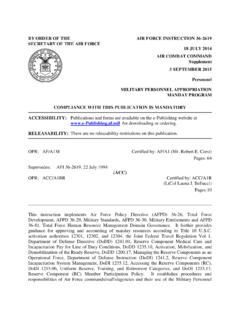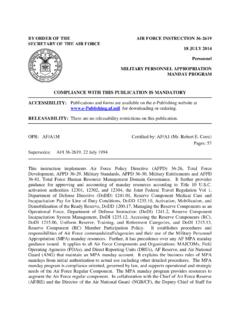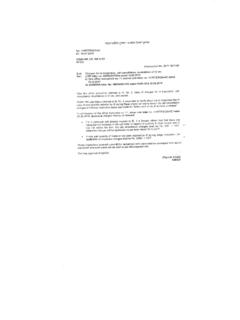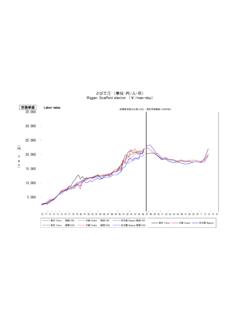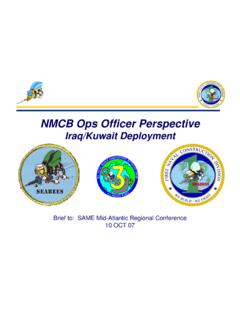Transcription of Outcomes of Rice Fallow Project in Chhattisgarh - NRAA
1 Outcomes of rice Fallow Project in ChhattisgarhIn the pilot study area of Chhattisgarh , agriculture field after harvest of Kharif (rainy) season rice are left uncropped in rabi (winter) season is typically called as rice Fallow . This situation largely occurs in rainfed rice , where irrigation facilities for either rice or a post- rice crop are not available. Estimated rice Fallow area in India was reported million ha in which 82% is found in eastern India. In Chhattisgarh Kharif rice is grown in lakh ha and 55-65% area remains Fallow after rice which is great challenge for food security and farmers economy. To address rice fallows and enhance Kharif crops productivity with diversified cropping, present pilot study entitled Capitalizing Opportunities of rice Fallows in Eastern India for Sustainable Livelihood Development was districts namely Gariyaband and Charama were selected for the study.
2 An area of 1500 ha was selected in both Charama and Gariyaband clusters. Thus total area of the pilot Project was 3000 GOAL AND overall goal of this Project was to contribute agriculture growth and increase farm productivity, income and employment in order to augment food security and reduce poverty as well as improving the natural resource conservation in the rice Fallow areas through optimization of the introduction of a second crop in the rice system. The specific objectives of the Project and pilot test the promotion of production or farming system focused at second crop/ alternate livelihood interventions in the rice fallows of Eastern and demonstrate convergence to support the systems perspective and a workable institutional mechanism for holistics development of rice new in-sights for next generation comprehensive rainfed area development/watershed programmes and identify the enabling policy options for sustainable development of rice the capacity of the developmental agencies and partners through joint collaboration and experience Identify problems and prospects.
3 Geographical area and Land use, area under Kharif, rabi and summer crops and varieties, status of mechanization, social problems, reasons for rice Fallow , irrigation status, socioeconomic status, status of natural resources and utilization, status of livestock, livelihood activities, prospects and possibilities of double cropping was collected and Awareness and Skill development:Success of any Project largely depends on awareness, involvement and skill development of all stakeholders including all participating farmers in transparent manner. To achieve the set goal; need based training, exposure visit of farmers and farm women, field day and farmers fair, method and skill demonstration and other extension tools were implemented for various Technology demonstrations:To get desired results from demonstrations it is necessary to select technology carefully considering the farming situation and resource base on crop production technology included selection of appropriate cropand variety, method of sowing, weed management, integrated nutrient and pest management, precision farming, use of water saving devices, use of various improved implements and machine Technologies for double cropping.
4 Short duration varieties and crops suitable for rainfed condition were selected. Improved varieties of crops also selected when 1-2 irrigations were available. Hybrid and high yielding varieties of rice , maize, wheat, pea, tomato, chili, brinjal, bitter gourd, bottle gourd, onion, ladyfinger, garlic, ginger, cabbage, cauliflower, cowpea, frenchbean and leafly vegetable selected with recommended package of Mechanization:Tractor, bullock and tractor drawn seed drill, drum seeder, self propelled harvester, combined harvester, duster and ploughing implements like cultivator, iron biasi plough, rotavator, bund former, MB plough, power sprayer, seed treating drum etc.
5 Were made available to the farmers on custom hiring basis for timely Water resources development and utilization:Water harvesting structures like farm pond, tank, diversion bund, loose rock dam, check dam, small ditch-chahla and recharging pit were constructed for rainwater harvesting and for efficient use of irrigation water are the prerequisites to increase irrigation efficiency and maximize crop yields. Planting cucurbits (pumpkin, bottle gourd, ash gourd) in pits without tillage and irrigate only in pit manually or by channel, sprinkler, drip system with poly mulch, low cost drip irrigation system, crop diversification like maize in place of rice should be Social problems and motivation:Stray cattle, cropping in groups/ patches, resource sharing, theft, social fencing etc.
6 Are the issues to be tackled by involvement of farmers. Farmers should be motivated for growing of rabi crops and adoption of innovative technologies. Social conflicts if any should be Feed, fodder, fruit and fuel plantations:Double cropping improves feed availability but fieldbund and irrigated fields should be used for growing green fodder like maize, chari and berseem. Fruit and forest plantation like mango, drumsticks, guava, banana, papaya in badi system and field bunds Khamar, bamboo, gataran and karonda on boundary side of the field should be Livelihood activities:Spine gourd, sem, arhar, til, cowpea, marigold on rice bunds, semialata, ber and palas on field bund backyard poultry, goat, pig and cow rearing, lac culture in kusum and ber, wadi system, NTFP, fish and duck rearing, spawn and mushroom production, vermin compost etc.
7 Are the options for adoption to increase income and employment in the Project Market linkages:Traditional marketing- transport product up to market and sale, produce lifting form field value addition and marketing, formation of group, branding and marketing should be promoted for competitive price of MAJOR Outcomes OF Beneficiary farmers:InGariyaband cluster 401farmers and1201population was benefitted where as 821farmers and 4678population were benefitted Irrigation and efficient water use:In Gariyabadcluster 24 ha area was irrigated before start of the Project and 361 haafter completion of the Project . Thus, ( to )cultivable area brought under irrigation using surface and ground water.
8 Irrigated area increased from 129 hato 548 ha as the impact of the Project in Mechanization:Mechanization and custom hiring services were promoted as a result large number of equipment and implements were procured by the farmers for cultivation of Organic manure:Large number of Nadep pits, vermin compost units and biogas plants came in to existence after implementation of the pilot Project and majority of farmers are using them for production of Integrated farming system models (IFS):Seven integrated farming system (IFS)models were promoted and adopted by the farmers. Small, marginal and big farmers were adopting the models and obtaining round the year income and employment on sustainable basis.
9 The Outcomes of these nine modules as IFS Model for ha farm size:Farmers were growing kharif rice by traditional biasi method, yielding low and also delayed rice harvest. After adopting dry and moist line sowing with weed control and recomanded package of practices, resulted in enhancement of productivity and early maturity of rice by 2 weeks, rice -Chickpea-Vegetables-Cow, farming system was adopted. This model obtained gross return of 3-5 lakhand net return of 2-3 lakhwith employment for 300-400 man IFS Model for ha Land:Farmers were growing rice before start of this Project that gave ; Rs lakhgross and lakhnet return along with 204 mandaysannually.
10 rice -Vegetables-Chickpea-CowIFS model was implemented for this land size for two years. The results showed significant increase in cropping intensity and rice yield. Net return of Rs. lakhwas obtained and Employment generated was 578 IFS Model for ha Land:One irrigated and another rainfed IFS models were tested under rainfed conditions, rice -Chickpea-Cow-Custom hiringmodel was tested. The result showed that rice yield increased nearly one-forth, chickpea yield was good, they earned around lakhfrom custom hiring and lakhfrom selling milk of cows. Altogether by adopting this model, a farmer may get lakhannually over lakhfrom traditional rice farming under irrigated condition, rice -vegetables-fruit- rice -cow model was implemented.
